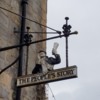Many history museums focus on the lives and glories of the rich and powerful, and the glorious past of whichever nation or city is being remembered. But for me, some of the richest museums focus on people who rate barely a mention in many of the others: the ordinary people, whether farmers, fishers or urban workers without whom history would be an empty shell.
We've been fortunate to visit a handful of museums devoted to working life and working-class life, and on a recent trip to Scotland we were able to visit one each in Edinburgh and Glasgow. Edinburgh call its museum 'The People's Story,' and has given it space in a historic building along the Royal Mile, the old city's main street.
As a museum of social history, the People's Story tells little about the parade of kings and nobles who've run the city, and focuses on changing conditions in which the people of the city lived, and how that changed over time. Once past the earliest times, there is also a focus on movements through which the common folk increasingly demanded and won changes in the city.
The museum occupies the Canongate Tollbooth, a 1591 stone pile that was built to collect tolls for the then-independent borough of Canongate that grew up around Holyrood Abbey. Among its functions, as late as 1848, was as a jail and debtor's prison; the scene above illustrates how that might have looked. In later years it served as a library, a fire station, police post and more until it became a museum in 1954.
On its lower floor, the museum's focus is on the 17th and 18th centuries, with exhibits on the ways in which Edinburghers earned a living and how they lived, which was, as the image at right shows, in very small spaces.
Widespread poverty, along with the crowd-ing made for a difficult life, and not always a great respect for the rules, to the distaste of the ruling classes, who created uniformed patrols to keep things under control.
A variety of skilled occupations were organized in 'Trade Incorporations,' a latter-day equivalent of the medieval guilds, to set standards for their trades and to regulate who could practice them. And there were 'civil service' jobs, such as that of the town crier.
Moving upstairs, the timeline shifts to the late 18th century through the early 20th. Edinburgh grew rapidly during that period, spreading out into its neighbors such as Leith, and becoming a center of industry, with major shipbuilding, textile and printing industries, but also many artisan and service businesses.
The growth of industry and employment did not always bring a better life for Edinburgh's workers, but by the mid 19th-century they had gained enough influence and enough organization to win better working conditions for many, and even to win modest old-age pensions as an alternative to the workhouse. And yes, even then, it was a political issue as this campaign poster indicates.
Was this notice written by a lawyer? Note that it assigns all responsibility for anyone hurt by the company's trucks and equipment to the victims whose "thoughtlessness and inattention" cause the accidents.
As the display below indicates, many women, especially unmarried ones, were part of the labor force in a wide variety of industries, although usually restricted to 'women's work' until World War I opened doors to other fields. But for much of the period covered, one of the largest fields for women was domestic service.
One of the women employed as a domestic worker was our One-Clue Mystery this week, and was recognized by George G after searching through a variety of similar historic sites. Although Annie Rafferty worked in the 20th century, her work was quit similar to that of the century before.
Fishermen's wives often worked not only on maintaining nets and gear but as the primary sellers of fish in the coastal edges of Edinburgh such as Newhaven. Much of the work done by Edinburgh's working-class women was not for pay; they kept house in crowded quarters and difficult conditions. One of the reforms that came in the 19th century created public washhouses with access to heated dryers that allowed women space that they did not have at home. They also became important social centers as well.
Other 19th-century social changes included the development of cooperative societies to provide services and access to food and other goods at lower cost. The Coop is still a major player in Scottish retail, and one of the biggest grocers.
While schemes to address the problem of crowded slum housing in the city began in the 19th century, including demolition of some of the worst slums, not much was done to build new housing until well into the 20th century as organized demands and movements grew. But, as the lower exhibit shows, some of the schemes, including huge apartment towers, didn't solve the whole problem.
This good-humored poster is only a sample of what the museum has to say about World War II, when daily life was complicated not only by food rationing but also by the growth of new war industries, training for air raids, and more. Edinburgh was hit by German bombers eighteen times during the war, with the docks high on the target list.
The 20th century also brought other kinds of social change, from the growth of mass interest in professional and amateur organized sports to changing trends and styles in public places.
One of the museum's proudest exhibits is its banner, assembled from a variety of materials and showing a panorama of the peoples and struggles that have made modern Edinburgh. A fitting symbol for a fascinating museum.


Comments (1)